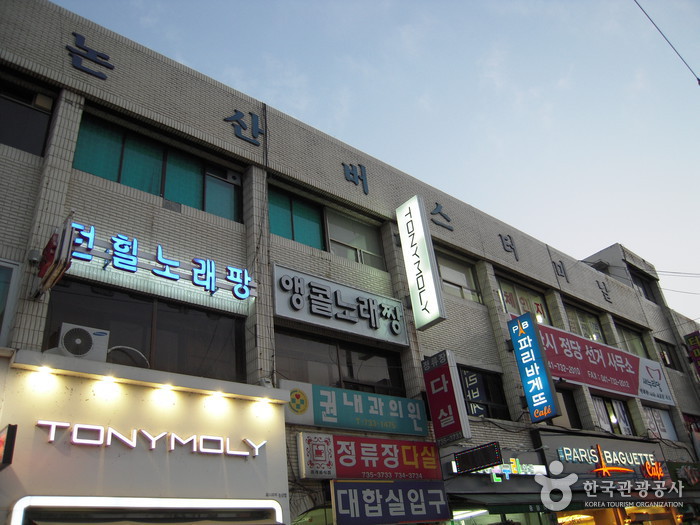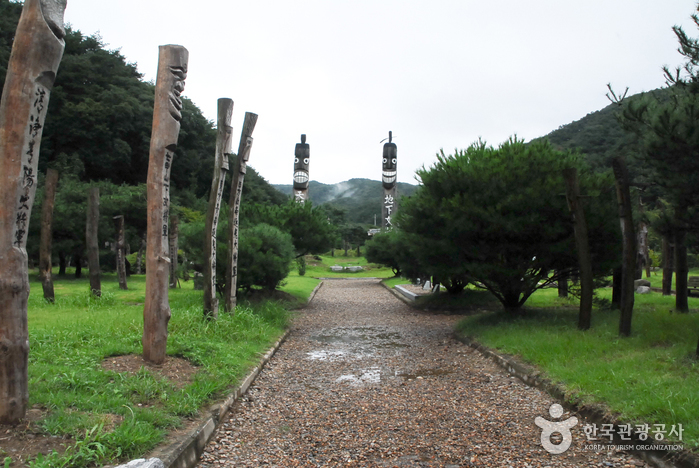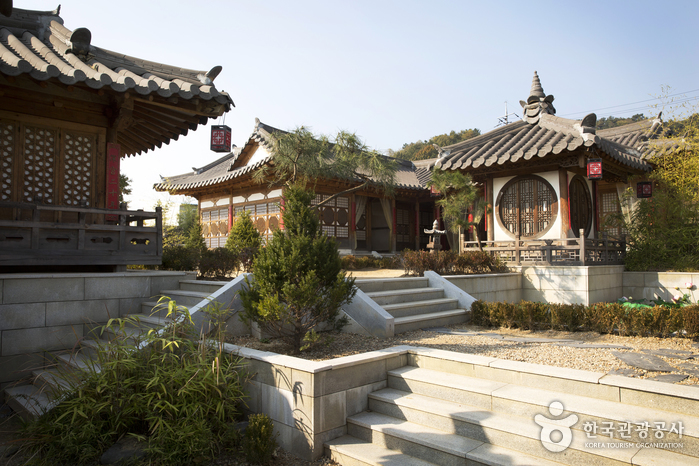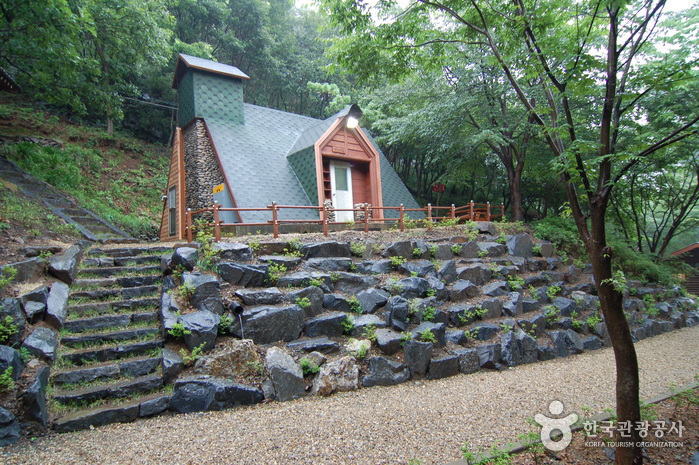Terminal des bus interurbains de Nonsan
15.2Km 2015-11-09
1045-1 Chwiam-dong Nonsan-si Chungcheongnam-do
Bonsuwon Wangsutbulgalbi (수원갈비)
15.3Km 2016-09-05
7-4, Jungang-ro 410beon-gil, Nonsan-si, Chungcheongnam-do
This restaurant is located at Meokjagolmok which is on the right side of Nonsan a cross-country bus terminal .Because it is built of wood and yellow earth, the inside is so warm and makes a traditional atmosphere. This restaurant accommodates 120 patrons and the kitchen and restroom are kept clean. All employee offer high quality service. Most of all , we can enjoy the abundant side dishes there.
Maison Myeongjae[Korea Quality] (논산 명재고택 [한국관광 품질인증])
16.5Km 2023-04-13
50, Noseongsanseong-gil, Noseong-myeon, Nonsan-si, Chungcheongnam-do
+82-41-735-1215, +82-10-6310-1139
Located in Noseong-myeon, Nonsan-si, Chungcheongnam-do, Myeongjae Historic House was built by Yun Jeung (pen-name: Myeongjae, 1629-1714), a scholar during the reign of King Sukjong (r. 1674-1720) of the Joseon Dynasty. It is said that although the king granted him a government post on eighteen occasions, Yun, being a straightforward sort of person, declined them all. As he practiced the virtue of simplicity and sharing in life and taught it to younger generations, the house escaped destruction during the Donghak Peasant Revolution (1894) and the Korean War (1950-1953) thanks to the efforts of his disciples. Thus, in keeping with his character, the house looks moderate compared to the homes of other aristocrats, although it exhibits a refined interior and a scientific design. The house consists of a sarangchae (men’s quarters), anchae (women’s quarters), and daecheongmaru (main floored room) configured in a square layout. The sarangchae itself consists of the keun sarangbang (large room) flanked by a daecheong and a numaru with an open view of the village and a mountain, the jakeun sarangbang (small room), the ansarangbang (inner room), and the daemungan (gate). To the right of the house is the spectacular sight created by a platform filled with hundreds of crocks for traditional sauces and condiments. The wall situated between the sarangchae and the anchae was designed to prevent people from looking into the anchae. There is also an open space below the wall from which one could see the shoes of a visitor, thus enabling the occupants of the anchae to know whether there was a visitor or not in the sarangchae. In addition, the gotganchae (storage quarters) situated next to the anchae is designed in such a way that it diminishes in size towards the north because the summer wind blowing from the south escapes the narrow passageway of the north, so it blows faster and the surrounding area gets colder, while the wind winter blowing from the north escapes the large passageway of the south, protecting the building from the bitter wind of the north. Therefore, the storeroom at the north end of the gotganchae remains cool even in summer, thereby preserving the things (food and other commodities) stored there. The guestrooms of the house include the three sarangbang rooms in the sarangchae building and the geonneonbang (a room opposite the main living room) in the anchae. The entire sarangchae building including the numaru can be rented too. Guests can also rent the thatched-roof byeolchae in the courtyard, which features a choyeondang equipped with a sound system and a beam projector, as well as a modern bathroom, for group meetings or performances. The house also runs a variety of paid traditional experience programs including Gukak (Korean classical music), tea ceremony, natural dyeing, and so on. Other noteworthy features of the house include the sarangchae’s distinctive gate, which combines a sliding door with a hinged door, the looming presence of a mountain to its rear, and the little round island (pond) planted with an old crape myrtle at its front.
Parc des Jangseung au mont Chilgapsan (칠갑산 장승공원)
17.0Km 2024-12-17
Janggok-ri, Daechi-myeon, Cheongyang-gun, Chungcheongnam-do
+82-41-940-2722
Le parc des jangseung sur la montagne de Chilgapsan est la plus grande zone de préservation des jangseung, les anciens totems de bois ou de pierre habituellement placés à l’entrée des villages pour chasser les mauvais esprits. Le parc a été établi en mai 1999 afin de favoriser la prise de conscience à propos de ces artefacts, et d’abriter les plus hauts jangseung de Corée (11,5 m) ainsi que des répliques de totems indigènes du monde entier. Aujourd’hui, on y organise toujours le festival annuel des jangseung du mont Chilgap, et c’est un site important découvrir l’histoire coréenne.
Lieu de Tournage de Seodongyo (서동요 테마파크)
18.2Km 2020-12-29
Chungcheongnam-do, Buyeo-gun, Chunghwa-myeon, Chungsin-ro 616
+82-41-832-9913
Situé il y a 1400 ans, le drama « Seodongyo » montre l’amour entre un roi de la Dynastie Baekje et une princesse de la Dynastie Shilla. Il fut tourné à Chungnam Buyeo-gu, dans le parc à thèmes de Seodongyo. Ce dernier propose de nombreux points forts tels que les résidences royales de Baekje et Shilla, l’endroit où les nobles tenaient leurs banquets, le village des roturiers, et le village des nobles. Vous pouvez également vous engager dans divers programmes de découverte comme le jegichagi, la fabrication de collier, l’essayage de costumes et bien plus.
L’entrée dans le parc est possible de 9h à 18h du lundi au vendredi et de 9h à 21h les weekends. Elle coute 2000 wons pour ceux âgés de plus de 18 ans et 1500 wons pour les autres.
* Décors
1) Résidence Royale du Roi de Baekje – deux étages à l’extérieur, un à l’intérieur
2) Résidence de Jwapyeong Buyeoseon – résidence du luxe pour les officiels hauts gradés
3) Palais de Shilla– 2 bâtiments composés du Palais de Shilla
4) Village Royal – Résidence Royale de Baekje et résidences des roturiers
5) Taehaksa – servant d’institut des sciences et technologies
6) Hwanghwagung – résidence de la Reine
7) Taejagung et Aeyeonji – étang rempli de fleurs de lotus, symbolisant l’amour de Seodong
8) Seodongjeong, Seonhwajeong – pavillon situé derrière la Résidence Royale de Baekje
9) Haneuljae – Village des Ingénieurs de Baekje situé sur la terre de Shilla
10) Sugyeongnu – lieu où les nobles tenaient leurs banquets
Baek il heon Head House [Korea Quality] / 논산 백일헌 종택 [한국관광 품질인증]
18.4Km 2020-09-08
45, Jugok-gil, Sangwol-myeon, Nonsan-si, Chungcheongnam-do
+82-41-736-4166 / +82-10-2911-4166
The Baegilheon Head House (National Folklore Cultural Heritage No. 273) is the house that was bestowed upon General Yi Sam by King Yeongjo in recognition of his achievement in suppressing the Yi In-jwa Rebellion in 1728. King Yeongjo also granted Yi Sam the posthumous name ‘Baegilheon’. The house is composed of the munganchae (gate quarters) situated next to a tall gate, the ‘ㄷ’-shaped anchae (women’s quarters), and the ‘ㄱ’-shaped sarangchae (men’s quarters), which are configured in an overall square layout. The accommodation includes the munganchae, the araet sarang with a numaru (upper floor), and the wit sarang and the geonneotbang, each of which has a large toenmaru (a narrow wooden porch running along the outside of the building). Notably, the geonneotbang, which is connected with the daecheong (wooden floor) and has a cozy courtyard surrounded by a mud wall, was the living space for the eldest son of the family and his wife for many generations. As the house has been designated as a National Folklore Cultural Heritage, cooking in the guestrooms is strictly prohibited. However, the house provides breakfast prepared by the daughter-in-law of the head house free of charge. The toilets and shower room are situated in the back yard.
La Forêt Chilgapsan (칠갑산자연휴양림)
19.4Km 2021-01-20
668-103, Chilgapsal-ro, Daechi-myeon, Cheongyang-gun, Chungcheongnam-do
+82-41-940-2428
La forêt Chilgapsan est située dans la partie ouest du parc r’egional Chilgapsan, qui est surnomé comme « les Alpes » de Chungcheongnam. La forêt abrite une variété d'installations, y compris des chalets, un centre de formation, des maisons traditionnelles coréennes, des salles de réunion, des installations sportives, un parc aquatique ainsi qu'un observatoire. Le site dispose également d'un domaine d'éducation sur la nature et des jeux pour les enfants. Les attractions touristiques à proximité comprennent le temple Janggoksa, la vallée Naengcheon, le lac Cheonjang, la rivière Gugokjicheon et le temple Modeoksa.


![Maison Myeongjae[Korea Quality] (논산 명재고택 [한국관광 품질인증])](http://tong.visitkorea.or.kr/cms/resource/40/1878940_image2_1.jpg)


![Baek il heon Head House [Korea Quality] / 논산 백일헌 종택 [한국관광 품질인증]](http://tong.visitkorea.or.kr/cms/resource/98/2530098_image2_1.jpg)

 Français
Français
 한국어
한국어 English
English 日本語
日本語 中文(简体)
中文(简体) Deutsch
Deutsch Español
Español Русский
Русский